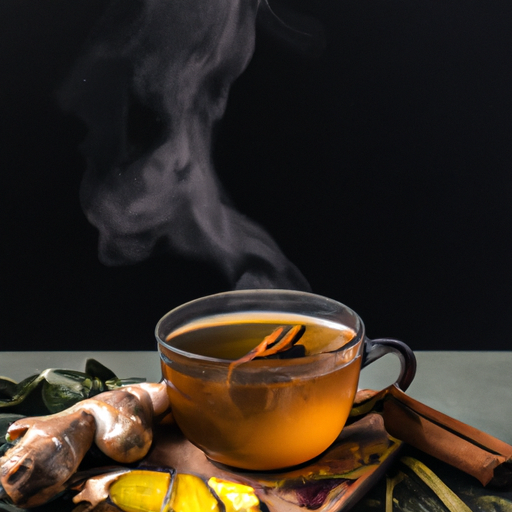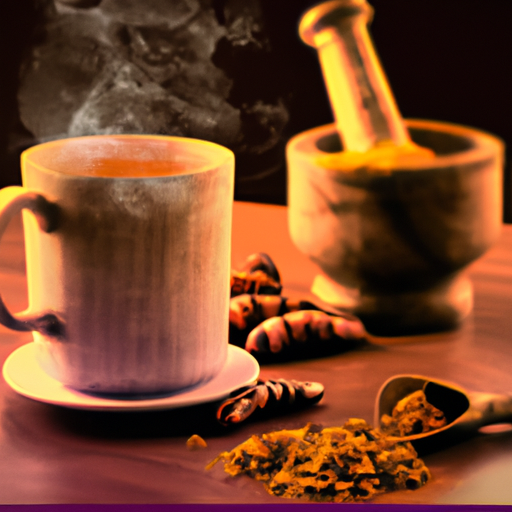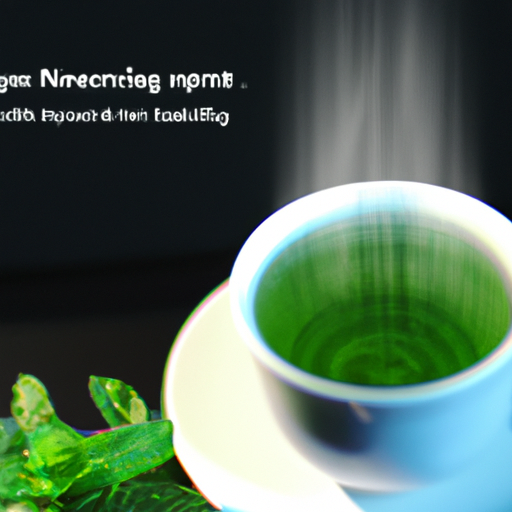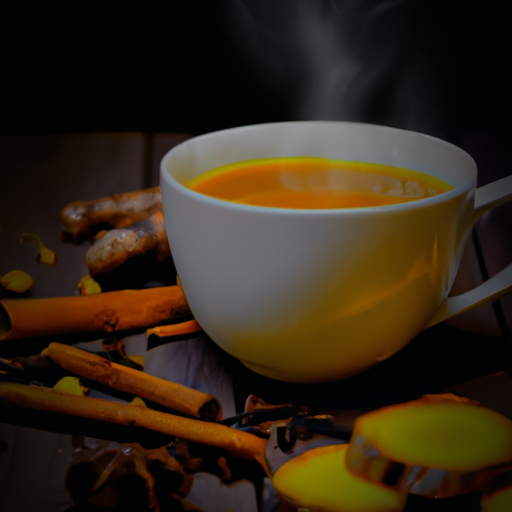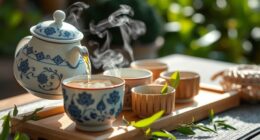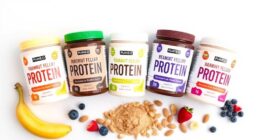As the saying goes, ‘two is better than one.’ And when it comes to natural remedies for inflammation, the combination of turmeric and ginger may just be a powerful duo. Inflammation is a common bodily response to injury or infection, but when it becomes chronic, it can lead to a range of health issues.
That’s where turmeric and ginger come in. Both of these spices have long been used in traditional medicine for their anti-inflammatory properties. Turmeric contains a compound called curcumin, which has been shown to reduce inflammation in the body. Ginger, on the other hand, contains gingerol, a potent anti-inflammatory substance. Together, these two ingredients work in synergy to help combat inflammation.
One popular way to incorporate turmeric and ginger into your routine is by making a soothing cup of tea. In this article, we will explore the benefits of turmeric and ginger, the science behind their anti-inflammatory effects, and how to make a delicious and nourishing turmeric and ginger tea.
So, let’s dive in and discover how this dynamic duo can support your body’s fight against inflammation.
Key Takeaways
- Turmeric and ginger are powerful natural remedies for inflammation.
- Turmeric’s curcumin and ginger’s gingerol have anti-inflammatory properties.
- Turmeric and ginger work together to combat inflammation.
- Drinking turmeric and ginger tea regularly improves digestion, boosts the immune system, and reduces joint pain.
The Benefits of Turmeric and Ginger
Combining turmeric and ginger in tea enhances their inflammation-fighting properties, making it a powerful elixir for soothing aches and pains.
Turmeric and ginger have been used for centuries in traditional medicine for their numerous health benefits. When brewed together, these two ingredients create a delicious and therapeutic beverage that can be enjoyed daily.
Turmeric is well-known for its active compound called curcumin, which has strong anti-inflammatory properties. It helps reduce the production of inflammatory molecules in the body, thus alleviating pain and swelling associated with inflammation. Ginger, on the other hand, contains gingerol, a bioactive compound that also possesses anti-inflammatory effects. By combining these two powerful ingredients, the inflammation-fighting potential of the tea is enhanced.
There are various recipes available for turmeric and ginger tea, allowing you to customize the taste to your liking. You can add other ingredients like honey, lemon, or black pepper to enhance the flavor and boost the health benefits even further.
Drinking turmeric and ginger tea regularly can help improve digestion, boost the immune system, and reduce joint pain.
Understanding inflammation is crucial in managing various health conditions. By incorporating turmeric and ginger tea into your daily routine, you can harness the anti-inflammatory properties of these ingredients and potentially alleviate inflammation-related symptoms.
Understanding Inflammation
Inflammation occurs in the body as a response to injury, infection, or irritation, and it’s a normal part of the body’s healing process. However, when inflammation becomes chronic, it can have detrimental effects on our health.
Chronic inflammation has been linked to a range of health issues, including heart disease, diabetes, and certain types of cancer.
Causes of inflammation
When it comes to the causes of inflammation, you might be surprised to learn that it can be compared to a smoldering fire, slowly spreading and causing damage throughout your body. Inflammation can be triggered by a variety of factors, including injury, infection, and autoimmune disorders. These factors stimulate the immune system, which releases chemicals that promote inflammation as a protective response. Acute inflammation is a normal and necessary process for healing, but when it becomes chronic, it can lead to serious health issues such as heart disease, diabetes, and arthritis. To address inflammation, there are natural remedies that can be effective, such as turmeric and ginger. Both of these spices have anti-inflammatory properties and can be easily incorporated into your diet or consumed as a tea. Transitioning into the subsequent section, it’s important to understand the effects of chronic inflammation on our health.
Chronic inflammation and its effects
Chronic inflammation, like a persistent storm raging within, wreaks havoc on our bodies and can lead to a host of debilitating health conditions. It is well-established that diet plays a significant role in chronic inflammation. Certain foods, such as processed meats and sugary snacks, can promote inflammation, while others, like fruits and vegetables, have anti-inflammatory properties.
Natural remedies are also gaining attention for their potential to reduce inflammation. Turmeric and ginger are two such remedies that have been used for centuries in traditional medicine. They both contain compounds with anti-inflammatory effects, such as curcumin in turmeric and gingerol in ginger. These compounds have been shown to inhibit the production of inflammatory molecules in the body.
Transitioning into the subsequent section, the synergistic effects of turmeric and ginger in reducing inflammation are worth exploring further.
The Synergistic Effects of Turmeric and Ginger
When it comes to addressing inflammation, combining turmeric and ginger can be an effective strategy. Both herbs have powerful anti-inflammatory properties that, when combined, can provide a synergistic effect.
Additionally, these two herbs can enhance the bioavailability and absorption of their active compounds, allowing for better therapeutic benefits.
By incorporating turmeric and ginger into our diet or consuming them together in tea, we can harness their potential to reduce inflammation and promote overall well-being.
Combining their anti-inflammatory properties
By combining the anti-inflammatory properties of turmeric and ginger, you can potentially alleviate joint pain and reduce swelling, offering relief to individuals with conditions like rheumatoid arthritis.
Both turmeric and ginger have been used for centuries in traditional medicine due to their numerous health benefits. Turmeric contains a compound called curcumin, which has potent anti-inflammatory effects. Ginger, on the other hand, contains gingerol, a compound known for its ability to reduce inflammation.
There are several ways to consume turmeric and ginger to maximize their health benefits. One option is to brew a tea using fresh or dried turmeric and ginger root. Another option is to add them to smoothies or juices. You can also incorporate turmeric and ginger into your cooking by adding them to soups, stews, or stir-fries.
In the subsequent section about enhanced bioavailability and absorption, we’ll explore how to optimize the body’s ability to absorb these beneficial compounds.
Enhanced bioavailability and absorption
To maximize the benefits of combining turmeric and ginger, it’s important to explore ways to enhance the body’s absorption of these powerful compounds. One method to achieve this is by increasing the bioavailability of the active ingredients. Research suggests that consuming these spices together can lead to enhanced absorption and increased potency. Turmeric contains a compound called curcumin, which has low bioavailability on its own. However, when combined with ginger, the absorption of curcumin can be improved significantly.
To understand the impact of this combination, let’s take a look at the following table:
| Turmeric alone | Turmeric and Ginger together | |
|---|---|---|
| A | Low potency | Increased potency |
| B | Suboptimal dosage | Optimal dosage |
| C | Limited benefits | Enhanced benefits |
As you can see, incorporating ginger into your turmeric tea can provide increased potency and optimal dosage, resulting in enhanced benefits for inflammation. Now, let’s move on to the next section and explore how to make turmeric and ginger tea.
How to Make Turmeric and Ginger Tea
When making turmeric and ginger tea, it’s important to consider whether to use fresh or powdered spices. Fresh spices can provide a more intense flavor, while powdered spices are more convenient.
Next, brewing techniques play a crucial role in extracting the beneficial compounds from turmeric and ginger.
Lastly, there are various recipes available for turmeric and ginger tea, each with its own unique combination of ingredients and flavors.
Choosing fresh or powdered spices
For the freshest and most potent flavor, you’ll want to choose either fresh or powdered turmeric and ginger for your inflammation-fighting tea. Both options have their own advantages and it ultimately comes down to personal preference.
Here are five key points to consider when choosing between fresh and powdered spices:
-
Fresh spices: Using fresh turmeric and ginger allows you to enjoy their vibrant flavors and aromas. Additionally, fresh turmeric and ginger may contain higher levels of certain beneficial compounds.
-
Powdered spices: Powdered turmeric and ginger offer convenience and ease of use. They’re readily available and can be easily stored for longer periods of time.
-
Health benefits: Both fresh and powdered turmeric and ginger have been associated with various health benefits. They possess anti-inflammatory properties and may help alleviate symptoms of inflammation-related conditions.
-
Taste and intensity: Fresh spices tend to have a stronger and more pronounced flavor, while powdered spices offer a milder taste.
-
Recipe compatibility: Consider the specific recipe and its requirements when choosing between fresh or powdered spices.
Now that we’ve discussed the choice of spices, let’s dive into the exciting world of brewing techniques and recipes for your turmeric and ginger tea.
Brewing techniques and recipes
When it comes to brewing tea with turmeric and ginger for inflammation, there are a few key brewing techniques and recipes to keep in mind.
One tip is to use fresh turmeric and ginger root instead of powdered spices, as they tend to have a more potent flavor and higher levels of beneficial compounds.
To brew the tea, you can simply grate or slice the fresh roots and steep them in hot water for about 10 minutes.
For added flavor and health benefits, you can also experiment with alternative ingredients such as lemon or honey. These can enhance the taste while providing additional anti-inflammatory properties.
In the next section, we will explore different ways of incorporating turmeric and ginger into your diet, beyond just tea.
Incorporating Turmeric and Ginger into Your Diet
To boost your health and fight inflammation, try incorporating a delightful blend of turmeric and ginger into your daily diet. These two powerful spices have been used for centuries in traditional medicine for their anti-inflammatory properties.
One way to include turmeric and ginger in your diet is by adding them to your smoothies. Simply blend a teaspoon of turmeric powder and freshly grated ginger with your favorite fruits and vegetables for a refreshing and nutritious drink.
Another option is to sprinkle turmeric and ginger on top of stir-fries. Not only will they add a burst of flavor, but they’ll also provide you with their beneficial properties.
Incorporating turmeric and ginger into your diet is a simple and effective way to reap their many health benefits. However, it’s important to note that these spices may have potential side effects and precautions. Therefore, it’s advisable to consult with a healthcare professional before making any significant changes to your diet.
By incorporating turmeric and ginger into your daily meals, you can enhance your overall well-being and potentially reduce inflammation in your body. So why not spice up your dishes and give these incredible spices a try?
Potential Side Effects and Precautions
Incorporating turmeric and ginger into your diet may have potential side effects and precautions, so it’s advisable to consult with a healthcare professional before making any significant changes to your routine. While both turmeric and ginger are generally safe when consumed in moderate amounts, excessive intake may lead to certain risks. Here are some potential risks and dosage recommendations to consider:
-
Stomach upset: Consuming large amounts of turmeric and ginger may cause gastrointestinal discomfort, including bloating, gas, and diarrhea. It’s recommended to start with small doses and gradually increase to assess your tolerance.
-
Blood-thinning effects: Both turmeric and ginger have blood-thinning properties, which can interfere with certain medications or increase the risk of bleeding. If you’re taking blood thinners or have a bleeding disorder, it’s important to consult with your doctor before incorporating these spices into your diet.
-
Allergic reactions: Some individuals may be allergic to turmeric or ginger, leading to symptoms like rash, itching, or difficulty breathing. If you experience any allergic reactions after consuming these spices, discontinue use and seek medical attention.
-
Dosage recommendations: While there’s no standard dosage for turmeric and ginger, a safe range is typically 1-3 grams per day for turmeric and 1-4 grams per day for ginger. It’s best to start with lower doses and adjust based on individual response.
Considering these potential risks and dosage recommendations, it’s crucial to consult a healthcare professional before incorporating turmeric and ginger into your diet. Now, let’s delve into the conclusion and final thoughts on this topic.
Conclusion and Final Thoughts
After discussing the potential side effects and precautions of using turmeric and ginger in tea for inflammation, it’s important to draw a conclusion and provide final thoughts on the matter.
As someone who values evidence-based information, I understand the importance of weighing the potential health risks associated with any natural remedy.
While turmeric and ginger have shown promising anti-inflammatory properties, it’s crucial to exercise caution when using them in high doses or for extended periods. Some individuals may experience gastrointestinal issues, such as stomach upset or acid reflux, when consuming large amounts of these spices. Additionally, those with gallbladder or kidney problems should consult with a healthcare professional before incorporating turmeric and ginger into their routine.
However, it’s worth noting that there are alternative natural remedies available for inflammation that may be better suited for certain individuals. For example, omega-3 fatty acids found in fish oil have been shown to have anti-inflammatory effects. Other options include green tea, which contains antioxidant compounds that may reduce inflammation.
While turmeric and ginger can be beneficial for managing inflammation, it’s important to be aware of the potential health risks and to consider alternative natural remedies. As always, it’s recommended to consult with a healthcare professional to determine the most suitable approach for your specific needs.
Frequently Asked Questions
Are there any specific ratios or measurements for combining turmeric and ginger in tea for maximum anti-inflammatory benefits?
To maximize the anti-inflammatory benefits of turmeric and ginger in tea, there isn’t a specific ratio or measurement. However, combining equal parts of both ingredients can provide a balanced flavor and potential health benefits.
Can turmeric and ginger tea help with conditions other than inflammation, such as joint pain or digestive issues?
Turmeric and ginger tea has potential benefits for joint health and digestive health. Studies suggest that these ingredients may help reduce joint pain and inflammation, as well as improve digestion.
Is it safe to consume turmeric and ginger tea every day, or should it be used sparingly?
Daily consumption of turmeric and ginger tea has pros and cons. While it can help reduce inflammation, excessive intake may cause digestive issues. Alternatives for managing inflammation include other herbal teas and dietary changes.
Can turmeric and ginger tea be consumed by pregnant women or individuals on certain medications?
Pregnant women should consult their healthcare provider before consuming turmeric and ginger tea, as it may interact with certain medications. It is important to prioritize their safety and well-being.
Are there any specific guidelines for storing turmeric and ginger to maintain their potency and freshness when making tea?
To maintain the freshness and potency of turmeric and ginger when making tea, store them in a cool, dark, and dry place. Avoid exposing them to moisture or sunlight, as these can degrade their quality.
Conclusion
In conclusion, incorporating a daily cup of turmeric and ginger tea into your routine can have a powerful impact on reducing inflammation in the body. The synergistic effects of these two powerful herbs work together to provide potent anti-inflammatory properties.
By regularly consuming this tea, you can potentially experience a decrease in pain and discomfort associated with inflammation. So, why not give it a try and harness the healing power of turmeric and ginger in a warm and comforting cup of tea? Start sipping your way to a healthier you today!

